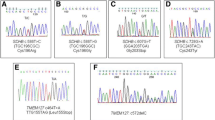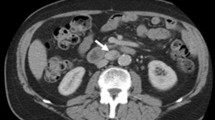Abstract
Pathogenic variants (PVs) in the SDHD gene increase risk for paragangliomas (PGL)/pheochromocytomas, renal cell carcinomas, and gastrointestinal stromal tumors. Penetrance in individuals with SDHD PVs varies in reported research from 40–70%, and there is limited evidence of specific genotype risks. This study aims to characterize a multi-generational family with SDHD p.Trp43* PVs and potential genotype–phenotype considerations for surveillance. Individuals with a paternally inherited SDHD p.Trp43*(c.129G > A) PV were identified. Genetic, medical and family histories were abstracted, including clinical characteristics, tumor histories, and treatment approaches. Eleven individuals with the SDHD PV in the same kindred were diagnosed with 41 SDHx-related tumors across all family members. Eight individuals developed 27 head and neck PGL of varying origins, and seven individuals developed tumors outside of the head and neck region. Many individuals had multiple tumors, and age of first tumor diagnosis ranged from age 10 to age 45 years old. Individuals with SDHD p.Trp43* variants may have higher risks for SDHx related tumors than other SDHD variants. Prioritizing identification of at-risk individuals and initiating surveillance tailored to family history is recommended given the rate of multiple tumors found in one familial branch of individuals under 18 years old. Individuals with strong family histories of PGL at young ages with this PV will benefit from tailored surveillance recommendations.

Similar content being viewed by others
Data availability
Additional clinical data is available and limited due to patient identifiers.
References
Andrews KA, Ascher DB, Pires DEV et al (2018) Tumour risks and genotype–phenotype correlations associated with germline variants in succinate dehydrogenase subunit genes SDHB SDHC and SDHD. J Med Genet 55(6):384–394
Else T, Greenberg S, Fishbein L (1993) Hereditary Paraganglioma-Pheochromocytoma Syndromes. In: Adam MP, Everman DB, Mirzaa GM et al (eds) GeneReviews® [Internet]. Seattle (WA): University of Washington, Seattle; 1993–2022. Available from: https://www.ncbi.nlm.nih.gov/books/NBK1548/?report=classic
Fishbein L, Nathanson KL (2012) Pheochromocytoma and paraganglioma: understanding the complexities of the genetic background cancer. Genet 205(1–2):1–11. https://doi.org/10.1016/j.cancergen.2012.01.009
Ricketts CJ, Forman JR, Rattenberry E et al (2010) Tumor risks and genotype-phenotype-proteotype analysis in 358 patients with germline mutations in SDHB and SDHD. Hum Mutat 31(1):41–51. https://doi.org/10.1002/humu.21136
Neumann HP, Pawlu C, Peczkowska M et al (2004) Distinct clinical features of paraganglioma syndromes associated with SDHB and SDHD gene mutations. JAMA 292(8):943–951. https://doi.org/10.1001/jama.292.8.943
Baysal BE (2004) Genomic imprinting and environment in hereditary paraganglioma. Am J Med Genet C Semin Med Genet 129C(1):85–90. https://doi.org/10.1002/ajmg.c.30018
Benn DE, Zhu Y, Andrews KA et al (2018) Bayesian approach to determining penetrance of pathogenic SDH variants. J Med Genet 55(11):729–734
Benn DE, Gimenez-Roqueplo AP, Reilly JR et al (2006) Clinical presentation and penetrance of pheochromocytoma/paraganglioma syndromes. J Clin Endocrinol Metab 91(3):827–836. https://doi.org/10.1210/jc.2005-1862
Gimenez-Roqueplo A-P, Caumont-Prim A, Houzard C et al (2013) Imaging work-up for screening of paraganglioma and pheochromocytoma in SDHx mutation carriers: a multicenter prospective study from the PGL.EVA investigators. J Clin Endocrinol Metab 98(1):162–173. https://doi.org/10.1210/jc.2012-2975
Saie C, Buffet A, Abeillon J et al (2020) Screening of a large cohort of asymptomatic SDHx mutation carriers in routine practice. J Clin Endocrinol Metab 106(3):e1301–e1315. https://doi.org/10.1210/clinem/dgaa888
Amar L, Pacak K, Steichen O et al (2021) International consensus on initial screening and follow-up of asymptomatic SDHx mutation carriers. Nat Rev Endocrinol 17(7):435–444. https://doi.org/10.1038/s41574-021-00492-3
Rednam SP, Erez A, Druker H et al (2017) Von hippel-lindau and hereditary pheochromocytoma/paraganglioma syndromes: clinical features, genetics, and surveillance recommendations in childhood. Clin Cancer Res 23(12):e68–e75. https://doi.org/10.1158/1078-0432.CCR-17-0547
Koenighofer M, Parzefall T, Frohne A et al (2021) Incomplete penetrance of a novel SDHD variation causing familial head and neck paraganglioma. Clin Otolaryngol 46(5):1044–1049. https://doi.org/10.1111/coa.13782
Jasperson KW, Kohlmann W, Gammon A et al (2014) Role of rapid sequence whole-body MRI screening in SDH-associated hereditary paraganglioma families. Fam Cancer 13(2):257–265. https://doi.org/10.1007/s10689-013-9639-6
Daniel E, Jones R, Bull M, Newell-Price J (2016) Rapid-sequence MRI for long-term surveillance for paraganglioma and phaeochromocytoma in patients with succinate dehydrogenase mutations. Eur J Endocrinol 175(6):561–570. https://doi.org/10.1530/EJE-16-0595
Tufton N, Sahdev A, Akker SA (2017) Radiological Surveillance Screening in Asymptomatic Succinate Dehydrogenase Mutation Carriers. Journal of the Endocrine Society 1(7):897–907. https://doi.org/10.1210/js.2017-00230
Greenberg S, Jacobs M, Wachtel H et al (2020) Tumor detection rates in screening carriers with SDHx-related hereditary paraganglioma-pheochromocytoma syndrome based on prior tumor history. J Clin Oncol 38(15_suppl):1545–1545. https://doi.org/10.1200/JCO.2020.38.15_suppl.1545
Van Duinen N, Steenvoorden D, Bonsing B et al (2010) Pheochromocytomas detected by biochemical screening in predisposed subjects are associated with lower prevalence of clinical and biochemical manifestations and smaller tumors than pheochromocytomas detected by signs and symptoms. Eur J Endocrinol 163(1):121–127
Martins RG, Cunha N, Simoes H et al (2020) Surveillance of succinate dehydrogenase gene mutation carriers: insights from a nationwide cohort. Clin Endocrinol. https://doi.org/10.1111/cen.14184
Tufton N, Sahdev A, Drake WM, Akker SA (2019) Can subunit-specific phenotypes guide surveillance imaging decisions in asymptomatic SDH mutation carriers? Clin Endocrinol 90(1):31–46. https://doi.org/10.1111/cen.13877
Bayley JP, Bausch B, Rijken JA et al (2020) Variant type is associated with disease characteristics in SDHB, SDHC and SDHD-linked phaeochromocytoma-paraganglioma. J Med Genet 57(2):96–103. https://doi.org/10.1136/jmedgenet-2019-106214
Cascon A, Ruiz-Llorente S, Cebrian A et al (2002) Identification of novel SDHD mutations in patients with phaeochromocytoma and/or paraganglioma. Eur J Hum Genet 10(8):457–461. https://doi.org/10.1038/sj.ejhg.5200829
Timmers HJ, Pacak K, Bertherat J et al (2008) Mutations associated with succinate dehydrogenase D-related malignant paragangliomas. Clin Endocrinol 68(4):561–566. https://doi.org/10.1111/j.1365-2265.2007.03086.x
Velasco A, Palomar-Asenjo V, Ganan L et al (2005) Mutation analysis of the SDHD gene in four kindreds with familial paraganglioma: description of one novel germline mutation. Diagn Mol Pathol 14(2):109–114
Amar L, Pacak K, Steichen O et al (2021) International consensus on initial screening and follow-up of asymptomatic SDHx mutation carriers. Nat Rev Endocrinol. https://doi.org/10.1038/s41574-021-00492-3
Buffet A, Ben Aim L, Leboulleux S et al (2019) Positive impact of genetic test on the management and outcome of patients with paraganglioma and/or pheochromocytoma. J Clin Endocrinol Metab 104(4):1109–1118. https://doi.org/10.1210/jc.2018-02411
Acknowledgements
The authors express deep gratitude to all members of the patient care teams, and most importantly, to our patients and this family, without whom none of our work would be possible.
Funding
This manuscript was supported in part by grant P30 CA2014 by the National Cancer Institute, awarded to Huntsman Cancer Institute.
Author information
Authors and Affiliations
Contributions
All authors contributed to the study conception and design. Material preparation, data collection and analysis were performed by MF, SG, JB, and AS. The first draft of the manuscript was written by MF and SG and all authors commented on previous versions of the manuscript. All authors read and approved the final manuscript.
Corresponding author
Ethics declarations
Competing interests
The authors do not report any conflicts of interest.
Ethical approval
This manuscript is approved by the University of Utah IRB#00046740.
Additional information
Publisher's Note
Springer Nature remains neutral with regard to jurisdictional claims in published maps and institutional affiliations.
Rights and permissions
Springer Nature or its licensor holds exclusive rights to this article under a publishing agreement with the author(s) or other rightsholder(s); author self-archiving of the accepted manuscript version of this article is solely governed by the terms of such publishing agreement and applicable law.
About this article
Cite this article
Foley, M., Sharma, A., Garfield, K. et al. A need to tailor surveillance based on family history: describing a highly penetrant familial paraganglioma kindred with an SDHD pathogenic variant. Familial Cancer 22, 217–224 (2023). https://doi.org/10.1007/s10689-022-00318-9
Received:
Accepted:
Published:
Issue Date:
DOI: https://doi.org/10.1007/s10689-022-00318-9




